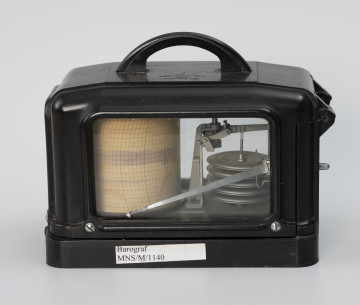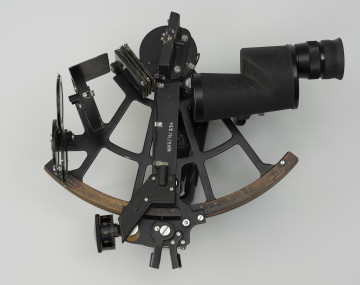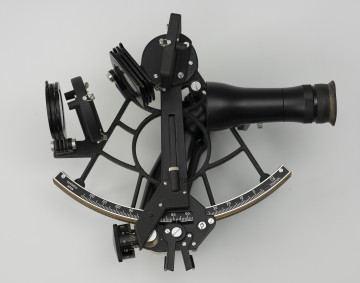
ŁM-1M barograph
1968
National Museum in Szczecin
Part of the collection: Equipment of watercrafts
Instruments for measuring pressure were known as early as the 17th century as a result of research by Evangelista Torricelli (1608-1647), an Italian mathematician and physicist, secretary to Galileo Galilei, who carried out the experiment underlying the design of the liquid barometer. However, it was not until the 1860s that the first operational device to record barometer readings was invented by Alexander Cumming (1733-1814), a Scottish watchmaker and inventor. Barographs constructed in line with his method of operation included barometers involving aneroids, and pressure sensors, the essential part of which is a vacuum membrane can, also known as a Vidi can. The deformation caused by changes in pressure inside it, for barometers, is transmitted to the pointer, and for barographs, through a lever mechanism fitted with a marker or pen at the end, the result of the pressure measurement is recorded on a barogram, a paper tape with a time scale. The barogram is placed on a rotating drum that moves clockwise. Depending on the design of the device, and in some models on the user's preference, the drum makes one revolution per day, week or month. Marine barographs used on ships have also often used the effect of vibration damping to offset recording interference caused by the constant motion of the ship on the waves. This was achieved by oil damping of the recording mechanism or by simple spring legs attached to the base of the device. The barograph in the collection of the National Museum in Szczecin was manufactured by VEB Feingerätebau Drebach. The company was founded by Kurt Fischer in 1945 in Drebach, in the Saxon Ore Mountains. It was nationalised during the time of the German Democratic Republic and only returned to the Fischer family after 1990 when it was re-privatised. The company specialises in the production of high-quality instruments for weather and climate monitoring both on land and at sea. Its measuring instruments used on ships include barometers, ship clocks, chronometers, and weather stations. To this day, most of the manufacturing is still done by hand, making the company famous for its top-quality products. Leszek Kocela
Author / creator
Object type
barometer
Technique
batch production
Material
metal, acrylic glass
Origin / acquisition method
legal transfer
Creation time / dating
Creation / finding place
Owner
Muzeum Narodowe Szczecin
Identification number
Location / status

1968
National Museum in Szczecin

1960 — 1970
National Museum in Szczecin

1983-02-28
National Museum in Szczecin
DISCOVER this TOPIC
National Museum in Szczecin
DISCOVER this PATH
Educational path